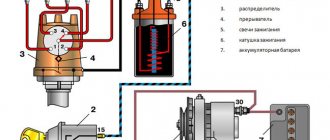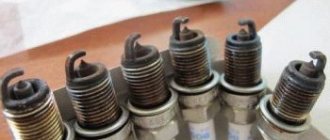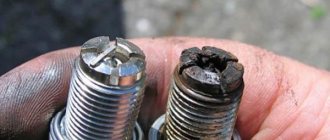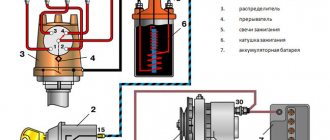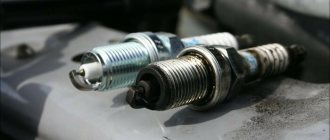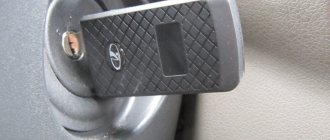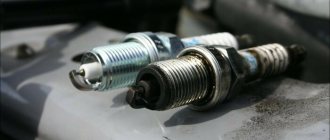When plugs are filled in on an injection engine, problems usually arise with starting it. For example, in the evening you returned from work, parked your car and calmly went home.
Morning comes, you need to go to work, but the car refuses to start. And the starter turns, but there are no signs of even attempts to ignite the fuel composition.
Therefore, a modern car enthusiast must be prepared for any surprises and be able to react to them correctly.
By the way, this phenomenon is typical for any type of fuel system (carburetor, injection - it doesn’t matter).
In most cases, trouble occurs in winter, when it is frosty outside. In the warm season, fuel filling the spark plugs on the injector occurs much less frequently.
So what to do?
Main reasons
First, let's look at the main reasons for this phenomenon. Surprisingly, the main source of problems in this case is the car’s ECU and the features of its firmware.
When it’s below zero outside, the system tries to create certain conditions for the fuel mixture. It is no secret that in frosty air the volume of oxygen is much higher.
So it turns out that the ECU sends an order to the injectors to supply a larger volume of fuel.
Naturally, “orders are not discussed” and the injectors increase the amount of gasoline injected.
READ ON THE TOPIC - The principle of operation of the injector.
Reasons for flooded spark plugs on the carburetor and injector
The main cause of the problem is considered to be incorrect operation of the “electronic brain” of the scooter.
At minus, to start the scooter, more force is required to mix the air-fuel mixture. This is due to the fact that at negative temperatures, a large amount of oxygen requires much more fuel. The “electronic brains” of the scooter see the problem arising and give a command to the injector nozzle to increase the supply of the combustible mixture. It is because of this that a problem arises in the engine compartment of your vehicle, especially if the battery on the scooter is not new. When gasoline is supplied by injectors to the combustion chamber, the starter tries to create sufficient compression in the cylinders and at the same time tries to produce a spark to create a flash. In combination with low-quality gasoline and the previously mentioned process, insufficient compression is created, due to which the scooter cannot be started. Only with perfect compression, which only a new scooter can boast, is it possible to avoid flooding of the injector spark plugs and start the scooter engine even with small impulses.
It is not difficult to guess that at sub-zero temperatures a weak spark is formed, the compression is insufficient, while the injectors supply a large amount of gasoline into the combustion chamber and it is for this reason that the spark plug is flooded with a combustible mixture, as a result of which the scooter does not show signs of life.
What's next?
The battery experiences enormous stress in the cold and may not produce the required voltage level (and there is no guarantee that it is new).
You turn the ignition key, the injectors deliver the required volume of gasoline into the combustion chamber, and the starter does its best to turn the crankshaft and create a sufficient level of compression in the engine.
At the same time, the candle is also trying to work.
Everything is true, but the quality of domestic fuel is far from being at the best level.
At the same time, in cold conditions (and not even in a new car), it is not always possible to achieve ideal compression.
The injectors have done their job, the spark plugs produce a spark “every once in a while”, and the compression level is too low. The result is flooded candles.
What to do if the spark plugs are flooded and how to start the car?
Replacing spark plugs
How to understand what has flooded the candles? By unscrewing them from the block head, the electrodes will be covered with moisture. But if the spark plugs are flooded in winter, including on the injector (injection engine), and there is no desire to “digging” in the engine in the cold, you can “blow out” the combustion chambers.
Often, “ventilating” the combustion chambers by starting the engine and depressing the gas pedal is quite enough to dry the spark plugs.
If the spark plugs are flooded and the car won’t start, there is no point in waiting for them to dry out. It is necessary to remove excess fuel from the chambers. The procedure is simple - press the gas pedal all the way, turn the engine with the starter for 10 seconds, release the pedal and try to start the engine. Cranking the engine with the throttle valve fully open “ventilates” the combustion chambers and dries out the spark plug insulators. But this method is good in cold weather and if the battery is in perfect condition. The most sensible thing to do would be to unscrew the candles, wipe them and dry them with an open flame - possibly on a gas stove. In such a case, of course, it’s a good idea to have a spare set, even if it’s not new, but still functional. The combustion chambers can also be cleaned by cranking the engine. With the spark plugs turned out, the load on the battery is significantly less. Unscrewing the spark plugs is also good because you won’t rack your brains trying to figure out what’s wrong with the engine—whether the spark plugs are filled with gasoline or something else has happened—for example, the fuel pump has failed.
We recommend: Automotive sealant - a universal tool for quickly repairing your car
What to do in this case?
Press the accelerator pedal all the way and turn the key in the ignition.
Crank the starter for 8-10 seconds. At the end of this time, the pedal can be returned to its original position.
In most cases, the engine starts.
The peculiarity of this method is that when the gas is fully pressed, the fuel supply to the engine is shut off, and the spark plugs themselves are blown exclusively with air.
If the engine still does not start, then you need to dry the spark plugs.
Why does the spark plugs fill when they are hot?
This type of malfunction, such as pouring spark plugs when they are hot, rarely occurs. Basically it happens like this: the engine started well when cold, heated up to the set temperature, drove for some time and suddenly stalled. Next, when you try to start the engine, the starter turns properly, there is gasoline, but the car does not want to start. Then, if you do nothing and leave it for a long time, the engine starts easily again. This is a sign of flooding of candles.
Reasons why spark plugs flood when the engine is hot:
- The spark plug itself is faulty (broken; the gap is either large or small;).
- The carburetor (if equipped) is not set correctly.
- Problems with the distributor (if any).
- Faulty wiring.
- Faulty sensors (mass air flow sensor).
- The high-voltage wire is broken.
- Malfunctioning injectors.
- Problems with the software (controller or firmware).
- Operating a car with a carburetor engine with an extended choke for a long time.
The way to solve the problem of flooding spark plugs in carburetor engines is to make sure that the fuel-air mixture is lean, to do this, purge for up to 10 seconds.
A way to solve the problem of flooding spark plugs in injection engines is to blow out the cylinders by opening or partially opening the throttles.
How to do it?
The tools you can use are a regular toothbrush (or a metal brush) and a hair dryer (for more effective drying).
If you have the opportunity to take the candles home, you can “calcinate” them in the oven or directly on the burners. But this method is only temporary.
If the candles have already expired, then it is better to simply change them.
It happens that almost every day the spark plugs on the injector are filled. In such a situation, it is necessary to carry out a full check of the elements - for the presence of spark output, cleanliness of the injectors, quality of the spark, and so on.
Interesting read: Iridium spark plugs, pros and cons.
What does spark plugs fill with?
Car spark plugs are usually filled with gasoline. But it can also be motor oil. Spark plugs that are filled with oil are much worse than if they are filled with gasoline.
When the car is idle for a long time in cold weather, unscrewing the spark plugs you can see oil dripping from the electrode or thread, but this may just be dirty condensation.
But, if in fact the spark plugs of an injector or carburetor engine are filled with oil, then the reasons for this may be:
- Cylinder liners are worn.
- Cylinders are worn out.
- The valve seals are worn out (the oil seals can be replaced without removing the head).
- Crack in the cylinder head.
- Valve guides are faulty.
- The valve cover gasket has failed.
- The spark plug wells are worn out.
- Oil scraper rings are worn out (cracked, stuck).
How to act to avoid trouble
There are several recommendations that will help minimize the occurrence of such problems:
- firstly, you need to monitor the battery charge level and periodically recharge it (this is especially true in winter);
- secondly, check the serviceability of the starter and if any problems arise, do not be lazy to go for diagnostics;
- thirdly, fill the engine with only the best quality oil, which is suitable for use in winter;
- fourthly, change spark plugs in a timely manner and inspect high-voltage wires for the fact of their probable failure;
- fifthly, adjust and clean the injector nozzles. This is easy to do - add one of the special compounds that are sold in stores to the tank;
- sixth, use high quality automobile fuel. To do this, refuel at trusted gas stations.
Remember that in the cold season the engine does not like small trips at low speed.
Therefore, in order to avoid problems, it is necessary to drive 50-80 kilometers at a time at least once a month and accelerate the car to 90-110 kilometers per hour (if, of course, road conditions allow).
If this is not possible, then periodically, while driving, increase the engine speed to 4-5 thousand revolutions. This is an excellent method for removing excess deposits and carbon deposits.
It’s important to read about the reasons why the car won’t start.
How to avoid flooding spark plugs with gasoline?
The most important criterion is to maintain the battery charge and the functionality of the starter. For this, sufficient conditions are created for the scooter to start even on the frostiest morning. In addition, you should fill in high-quality oil and use high-quality gasoline with a sufficient octane number, as specified in the operating manual of the purchased scooter. As a preventative measure, it is worth cleaning and adjusting the injector nozzles.
People's Council
To prevent the spark plug from flooding with gasoline during the cold season, you should occasionally “spin” your scooter to maximum and move at a speed slightly above average, thus increasing the load on the scooter’s engine at high speeds, due to which self-cleaning of carbon deposits and excess in the combustion chamber occurs.
By fulfilling all these basic requirements, you can not only eliminate problems associated with filling spark plugs with gasoline, but also increase the service life of your scooter’s engine significantly. By following all the above instructions, you will not have to contact a car service center again for expensive service.


